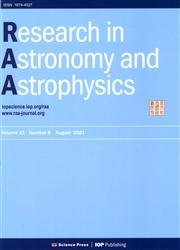使用低推力多重力辅助技术的第二颗地球特洛伊小行星2020 XL5会合任务
IF 2.8
4区 物理与天体物理
Q3 ASTRONOMY & ASTROPHYSICS
引用次数: 0
摘要
作为地球的第二颗特洛伊小行星,2020 XL 5在许多方面都值得交会甚至样本返回任务。在本文中,提出了一个与地球的第二颗特洛伊小行星2020 XL 5的交会任务。然而,由于其倾角大、偏心距大,直接脉冲传递需要大量的燃料消耗。为了应对这一挑战,我们探索了电力推进和多重力辅助技术在行星际任务中的好处。这两种技术被整合到这次任务设计中。对多体动力学中低推力重力辅助弹道的设计进行了深入研究,这是一个复杂的过程。本文提出了一个包含三个步骤的综合框架,用于多体动力学中LTGA轨迹的优化。2020年XL - 5的交会任务是按照这种三步方法设计的。结果中最有效的转移顺序是地球-金星-地球-金星-2020 XL 5。数值计算结果表明,电力推进与多重力辅助相结合可以大大降低燃料消耗,燃油消耗为9.03%,是本次交会任务的非常有利的选择。本文章由计算机程序翻译,如有差异,请以英文原文为准。
A Rendezvous Mission to the Second Earth Trojan Asteroid 2020 XL5 with Low-Thrust Multi-Gravity Assists Techniques
Abstract As the second Earth's Trojan asteroid, 2020 XL 5 is worthy of rendezvous and even sample return missions in many aspects. In this paper, a rendezvous mission to Earth's second Trojan asteroid 2020 XL 5 is proposed. However, due to its high inclination and large eccentricity, direct impulsive transfer requires large amounts of fuel consumption. To address this challenge, we explore the benefits of electric propulsion and multi-gravity assists techniques for interplanetary missions. These two techniques are integrated in this mission design. The design of low-thrust gravity-assists (LTGA) trajectory in multi-body dynamics is thoroughly investigated, which is a complex process. A comprehensive framework including three steps is presented here for optimization of LTGA trajectories in multi-body dynamics. The rendezvous mission to 2020 XL 5 is designed with this three-step approach. The most effective transfer sequence among the outcomes involves Earth-Venus-Earth-Venus-2020 XL 5 . Numerical results indicates that the combination of electric propulsion and multi-gravity assists can greatly reduce the fuel consumption, with fuel consumption of 9.03\%, making it a highly favorable choice for this rendezvous mission.
求助全文
通过发布文献求助,成功后即可免费获取论文全文。
去求助
来源期刊

Research in Astronomy and Astrophysics
地学天文-天文与天体物理
CiteScore
3.20
自引率
16.70%
发文量
2599
审稿时长
6.0 months
期刊介绍:
Research in Astronomy and Astrophysics (RAA) is an international journal publishing original research papers and reviews across all branches of astronomy and astrophysics, with a particular interest in the following topics:
-large-scale structure of universe formation and evolution of galaxies-
high-energy and cataclysmic processes in astrophysics-
formation and evolution of stars-
astrogeodynamics-
solar magnetic activity and heliogeospace environments-
dynamics of celestial bodies in the solar system and artificial bodies-
space observation and exploration-
new astronomical techniques and methods
 求助内容:
求助内容: 应助结果提醒方式:
应助结果提醒方式:


